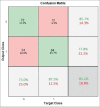Predictive Value of Blood Markers in Nonfunctional Pituitary Adenomas using Artificial Neural Network
- PMID: 37200767
- PMCID: PMC10186052
- DOI: 10.4103/abr.abr_183_21
Predictive Value of Blood Markers in Nonfunctional Pituitary Adenomas using Artificial Neural Network
Abstract
Background: Nonfunctioning pituitary adenomas (NFPAs) are the most common pituitary tumors and although they do not secrete hormones, they can have systemic effects. These tumors affect the function of other organs in the body by exerting pressure on the pituitary gland. There are differences between biomarkers NFPAs compared to healthy people. This study was conducted to show blood marker changes in adenomas compared to healthy people.
Materials and methods: This article compared the blood markers of NFPAs with healthy individuals retrospectively. The difference between blood markers in the two groups was statistically investigated where the predictive value of blood markers in the differentiation of the two groups was determined. An artificial neural network was also designed using the blood markers with its accuracy and predictive value determined.
Results: A total of 96 NFPAs (nonfunctional pituitary adenoma) and 96 healthy individuals were evaluated. There was statistically a significant difference and positive correlation in platelet to lymphocyte ratio, neutrophil to lymphocyte ratio, and derived neutrophil to lymphocyte ratio between NFPAs and healthy individuals. There was a significant and negative correlation between red blood cell (RBC), lymphocyte, and monocyte between the two groups. RBC as an independent factor was associated with NFPAs. In this study, the artificial neural network was able to differentiate between NFPTs cases and healthy individuals with an accuracy of 81.2%.
Conclusion: There are differences between blood markers in NFPAs relative to healthy people and the artificial neural network can accurately differentiate between them.
Keywords: Neural network; biomarkers; erythrocyte count; lymphocytes; neutrophils; pituitary neoplasms.
Copyright: © 2023 Advanced Biomedical Research.
Conflict of interest statement
There are no conflicts of interest.
Figures




References
-
- Szwagrzyk E. Visual disorders in pituitary adenoma and their treatment. Folia Med Cracov. 1964;6:101–42. - PubMed
-
- Al-Dahmani K, Mohammad S, Imran F, Theriault C, Doucette S, Zwicker D, et al. Sellar masses: An epidemiological study. Can J Neurol Sci. 2016;43:291–7. - PubMed
-
- Davis JR, Farrell WE, Clayton RN. Pituitary tumours. Reproduction. 2001;121:363–71. - PubMed
-
- Pelsma IC, Verstegen MJ, de Vries F, Notting IC, Broekman ML, van Furth WR, et al. Quality of care evaluation in non-functioning pituitary adenoma with chiasm compression: Visual outcomes and timing of intervention clinical recommendations based on a systematic literature review and cohort study. Pituitary. 2020;23:417–29. - PMC - PubMed
-
- Iwasaki Y. Pathophysiology and clinical features of non-functioning pituitary adenoma. Nihon Rinsho. 2011;69 Suppl 2:138–41. - PubMed
LinkOut - more resources
Full Text Sources
